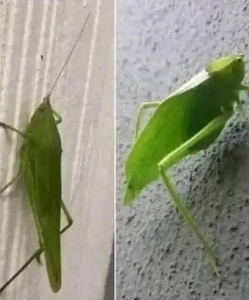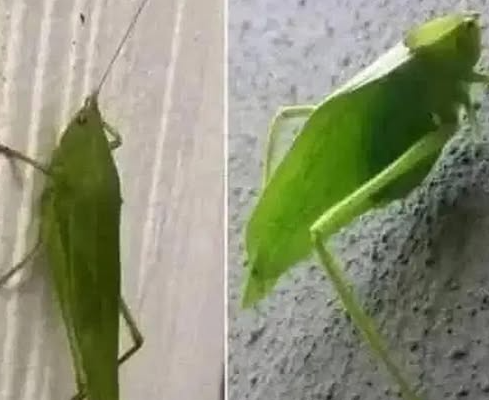



Nature is full of hidden conversations. While humans use words, gestures, and digital devices to communicate, insects have evolved their own remarkable ways to send and receive messages. One of the most fascinating examples of this can be found in the leaf grasshopper — a master of disguise and an incredible messenger in the insect world.
This story isn’t about human technology or satellites. It’s about how a small, green insect with delicate wings can become part of a sophisticated communication network in the wild — a network built on vibrations, sounds, colors, and subtle signals.
🌿 1. Meet the Leaf Grasshopper
The leaf grasshopper — a member of the order Orthoptera — is a remarkable insect that looks almost exactly like a leaf. Its wings mimic the veins, edges, and textures of real foliage so perfectly that even predators struggle to spot it.
Its camouflage serves as its first “message”:
“I am not a bug — I’m just another leaf.”
This form of visual messaging is crucial to its survival. Birds, lizards, and other predators searching for a snack often pass right by it without noticing.
But the leaf grasshopper isn’t just a silent mimic. It uses vibrations, body language, and chemical signals to communicate with others of its kind — and sometimes, indirectly, with other creatures in its environment.
📡 2. The Language of Vibrations
Unlike humans, leaf grasshoppers don’t rely on audible voices. Instead, they often “speak” through vibrations sent through leaves and stems.
This method, called substrate-borne vibration communication, works like this:
-
The grasshopper perches on a leaf or stem.
-
It rubs or taps parts of its legs or abdomen against the surface.
-
This creates tiny vibrations that travel through the plant.
-
Another grasshopper, perched nearby, feels the signal through its legs.
To us, these signals are inaudible. But to the insects, they carry messages like:
-
“I’m here.”
-
“This is my territory.”
-
“I’m ready to mate.”
-
“Danger nearby.”
This “vibration messaging system” is remarkably precise. Different rhythms, intensities, and durations can change the meaning — like words in a sentence.
🪶 3. Camouflage and Signaling: A Dual Role
What makes the leaf grasshopper fascinating is its ability to blend in and communicate at the same time.
For most of the day, it remains still, merging with the background. But when it needs to reach another insect, it can switch from silent to signaling mode.
This duality helps it:
-
Avoid predators by staying hidden.
-
Attract a mate or warn others when necessary.
-
Maintain a low communication “footprint” — unlike crickets or cicadas, which are easily heard.
It’s a master of quiet messaging — the insect version of encrypted whispers.
💕 4. Courtship: A Rhythmic Love Letter
During mating season, leaf grasshoppers engage in a remarkable courtship ritual based on vibration patterns.
The male typically starts the “conversation” by sending out pulsed vibrations through the leaf he’s sitting on. These are specific to his species — like a unique ringtone.
If a female is nearby and interested, she responds with a slightly different rhythm. This back-and-forth exchange continues until they locate each other.
In some species, these vibrations even form duets that can last several minutes. To the grasshoppers, this is not random tapping — it’s a meaningful, structured dialogue.
💬 A scientist once described it as “a love song too quiet for human ears.”
⚠️ 5. The Warning Network
Communication isn’t just about love — it’s also about survival.
When a leaf grasshopper senses danger, such as a bird approaching, it can send rapid, sharp vibrations down the leaf or stem. This can alert nearby grasshoppers to stay still or flee.
Some researchers believe these warning signals can ripple through multiple leaves in a plant, alerting several insects at once. This creates a silent alarm system that works faster than visual cues.
🧪 6. Chemical Messaging in the Air
While vibration is their main communication tool, leaf grasshoppers also make use of chemical signals, or pheromones.
These chemicals act like invisible messages carried on the wind:
-
A female ready to mate may release a pheromone to draw males in from a distance.
-
A grasshopper in danger may release alarm chemicals that trigger defensive behavior in others.
These airborne signals are crucial when vibrations can’t travel far enough — like when grasshoppers are on separate plants.
🌎 7. The Leaf as a Natural Communication Device
One of the most extraordinary parts of this messaging system is the leaf itself. The leaf isn’t just a resting place — it’s the medium through which the message travels.
Think of it like a natural telephone line:
-
The stem acts like a wire.
-
The leaf blade acts like a speaker.
-
The insect’s body is the dialer and receiver.
The shape, thickness, and moisture content of the leaf affect how well the signal travels. That means grasshoppers instinctively choose the best “network” leaves to send their messages.
🕷️ 8. Eavesdroppers and Predators
Of course, any communication system has risks. Predators like spiders, bats, and parasitic flies have evolved ways to eavesdrop on insect signals.
For example:
-
Some spiders can detect vibrations through their webs or nearby plants and locate grasshoppers.
-
Certain parasitoid flies can pick up on low-frequency vibrations and home in on their source.
This forces the leaf grasshopper to be selective and careful about when and how it communicates — using short bursts of signals or waiting for the right moment to “speak.”
🧠 9. A Natural Model for Human Technology
Interestingly, scientists studying leaf grasshoppers have found parallels between their communication and modern human technologies:
-
Substrate-borne vibration is similar to fiber-optic or wired signals, traveling through a medium.
-
Low-energy signaling allows for discreet communication without attracting too much attention — much like encrypted low-bandwidth networks.
-
Adaptive messaging based on environment mirrors how modern systems adjust signals for better clarity.
Some researchers in biomimetics are exploring how insect communication could inspire new technologies in environmental sensing, robotics, and communication in remote areas.
🌺 10. A Silent Symphony in the Forest
If you were to walk through a forest or garden on a warm day, you might not hear anything unusual. But beneath the surface of that silence, a hidden conversation is happening.
Thousands of tiny insects, including leaf grasshoppers, are sending messages through the green network of stems and leaves.
It’s a silent symphony — no loud chirps, no human words, but a language just as complex:
-
Calls of attraction.
-
Alarms of danger.
-
Territorial claims.
-
Courtship songs.
-
Coordination of movement.
This communication web connects insects with each other and with their environment in ways we’re only beginning to understand.
🧭 Why It Matters
Understanding the leaf grasshopper’s messaging system isn’t just fascinating — it’s important for:
-
Conservation: Protecting insect habitats preserves these communication networks.
-
Science: Studying natural communication inspires new technologies.
-
Ecology: Insects are indicators of ecosystem health. Their communication patterns can reveal environmental changes.
If leaf grasshoppers fall silent — due to pesticides, habitat loss, or climate shifts — it may be a warning sign that the ecosystem is in trouble.
🌿 Final Thoughts
The leaf grasshopper is more than a beautifully camouflaged insect. It is a messenger in one of the oldest communication networks on Earth. Through tiny vibrations, chemical whispers, and silent signals, it connects with others, warns of danger, finds mates, and helps maintain the delicate balance of nature.
The next time you see a leaf gently quiver on a still day, look a little closer. It might not be the wind.
It might be a leaf grasshopper, sending a message into the green world — one we humans are only just beginning to decode. 🦗✨

